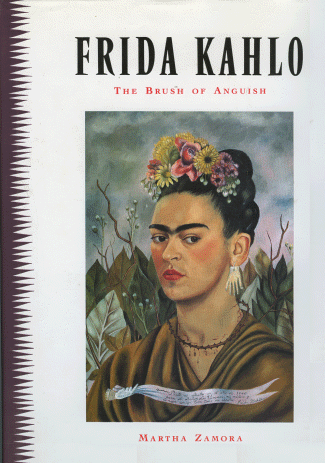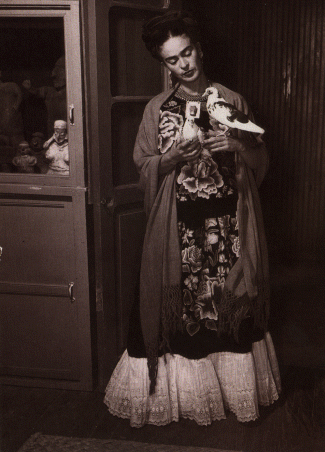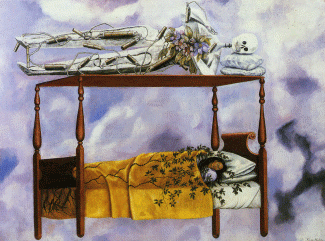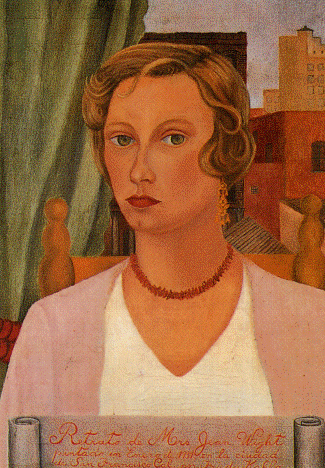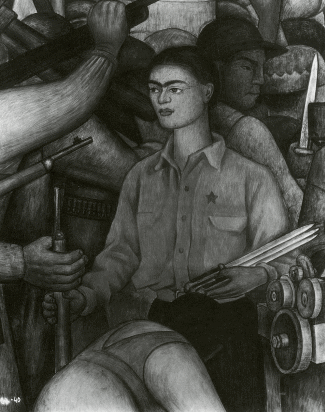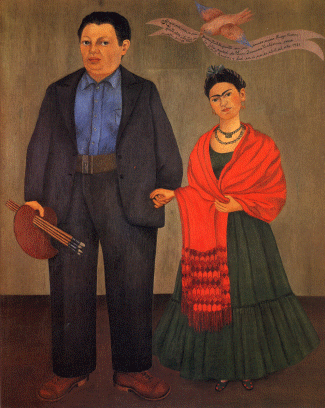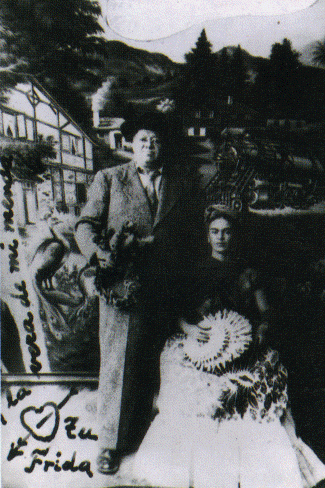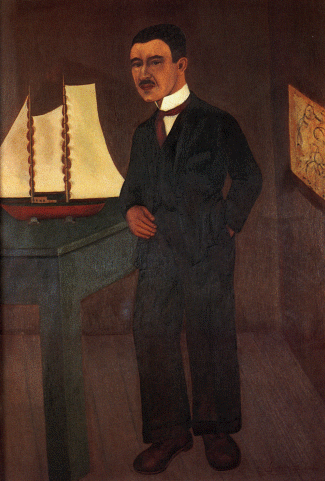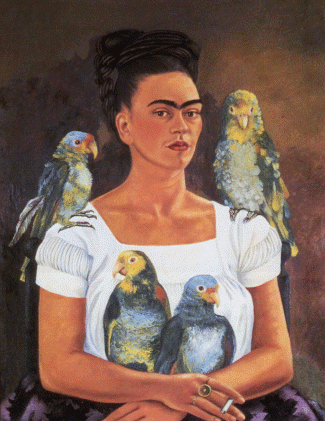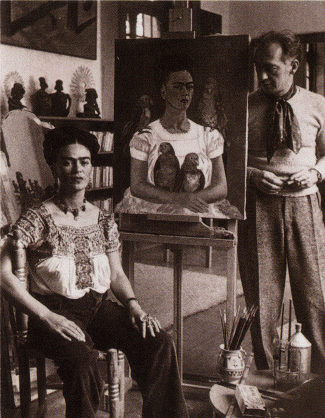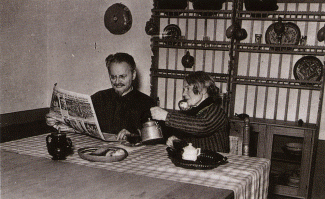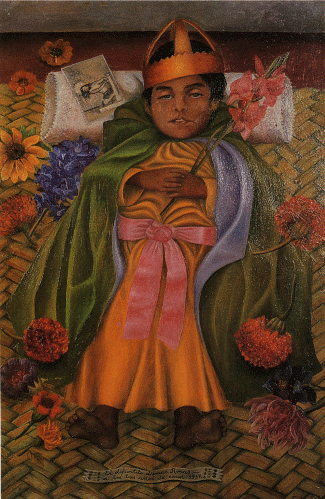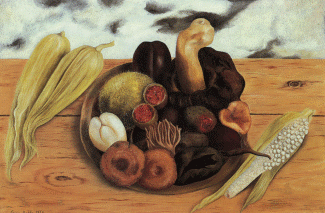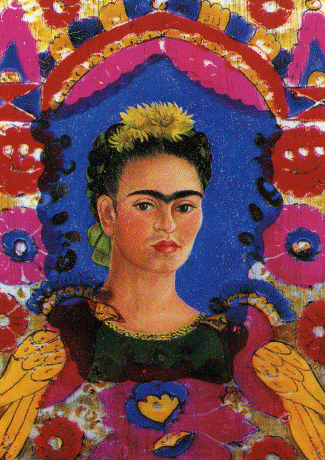The Beginning, Part 2Frida went to school dressed in a white middy blouse and a big tie, a navy blue pleated skirt, and a straw hat decorated with bows. Her sister Adriana fixed the bows for her, bur under precise instructions from Frida, who claimed her sister "had no sense of line or harmony." Always conscious of her appearance and her effect on others, Frida was daring enough on occasion to wear a man's suit or dramatic dresses of her own design.
 Portrait of Diego Rivera, 1937
Portrait of Diego Rivera, 1937Her school notebooks were filled with sketches, including one of herself in her straw hat, her dark hair cut in straight bangs, her signature black eyebrows growing together across her forehead. Bur although she studied composition and drawing, art was merely an amusing pastime. Frida was more attracted to the intellectual pursuits of a student group known as the Cachuchas, so named for the crocheted red caps they wore. An informal gang of nine, the Cachuchas had strong political concerns as well as interests in poetry, art, literature, history, and philosophy; all read at least one foreign language. Frida called the young men her carnales, blood brothers, and the girls were like sisters, her 'manas.
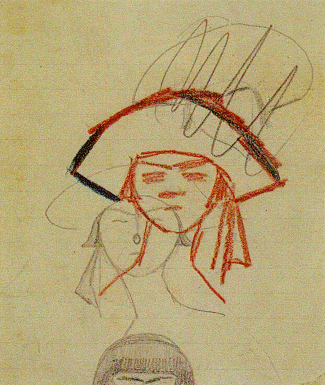 A page from Frida's school notebook, c. 1922
A page from Frida's school notebook, c. 1922At about this time Frida announced to friends, "You don't know what I would give to have a child by Diego Rivera." Her fellow students were stupefied, for despite their admiration for his talent as a painter, they saw him as a fat, untidy, bulging-eyed married man. Rivera was then working on his frescoes at the school, and Frida subjected him to her tricks. Once she soaped the school steps, hoping to make him slip and fall; other times she teased his wife, Lupe Marin, about other women in Diego's life.
Frida fell in love, however, with the charismatic leader of the Cachuchas, Alejandro Gomez Arias, an intelligent, attractive, well-mannered young man of a good family. "We were very good friends all our lives; we were more than sweethearts but never had wedding plans or anything like that, because we were still very young," Gomez Arias has said. Frida's ardent correspondence with Alejandro reveals her maturation from a young girl into a woman. Years later she said, "For me, Alex ignited love, the ambition to know, to know it all."
Frida's precocious behavior worried her parents. Societal restraints on women were severe, and even the concept of coeducation was upsetting to the families of proper young ladies. But Frida enjoyed flouting the rules, whether by a small transgression like wearing bobby socks, prohibited by the school dress code, or by a deviation as extreme as a sexual adventure with an older woman. This affair and other relationships not only scandalized her family but caused Frida to be ostracized by many of her schoolmates. Her passionate temperament had little respect for limitations, and Frida was not ashamed of her blossoming sexuality. She wrote to Gomez Arias: "I don't care. I like myself the way I am."
Guillermo Kahlo's business began to flounder while Frida was attending the Prepa, and as his financial situation worsened, he was forced to mortgage the Casa Azul. In order to help out, Frida enrolled in a business school in 1925 and learned to type. Her first jobs in a pharmacy and lumber yard office were unsuccessful, but eventually she was employed as an apprentice in an engraving studio.
***
That same year, on September 17, Frida and Alejandro spent the afternoon wandering among the colorful street stalls set up for Mexican National Day celebrations. On boarding a train to return to Coyoacan, Frida discovered that she had lost a little toy parasol Alejandro had just bought for her. They retraced their steps, and when it couldn't be found, they bought a balero, a cup-and-ball.
A bus happened by, a brightly painted new one with two long benches along the sides. Frida and Alejandro felt lucky to catch it. The driver, rushing to cross the busy city on the way out of town, boldly tried to pass in front of a turning streetcar. He didn't succeed: the heavy streetcar moved forward and collided with the bus, pushing relentlessly into its side and pressing against the benches where the passengers sat.
Gomez Arias still marvels at the elasticity of the vehicle, remembering that he felt his knees pressing against those of the person sitting across from him, just before the bus shattered to pieces. He regained consciousness underneath the streetcar, with the darkness of the metal chassis above him and a terrible fear that it would continue moving and mangle him. When he was able to sit up, he noticed that the front of his coat had somehow disappeared. He set out to find Frida.
At the moment of the accident, Frida was more concerned about the loss of her new toy, which had flown out of her hand,- than she was with the seriousness of the collision. Alejandro found her bathed in blood, without her clothes, virtually impaled on the rod of a metal handrail. A bag carried by a passenger had spilled gold powder all over, and Frida's bloodied body was sprinkled with it. Curious onlookers cried, "Help for the little ballerina!"
 Self-Portrait Wearing a Velvet Dress, 1926
Self-Portrait Wearing a Velvet Dress, 1926 Frida, 1926
Frida, 1926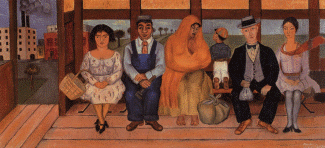 The Bus, 1929
The Bus, 1929 Accident, 1926
Accident, 1926An overall-clad worker, whom Alejandro thought he recognized as an employee of the Prepa, looked at Frida and said, "That has to be taken out of her." With no more ado he pulled the metal rod out of Frida's body to the terrible sound of breaking bones. Alejandro, horrified, carried her to a pool hall across the street, put her on a table, and covered her with the shreds of his ruined coat. They waited for an ambulance as Frida screamed in pain.
The wounded victims were taken to a nearby Red Cross hospital and divided into two groups: those who would receive immediate medical attention and those who, because of their grave condition, were considered beyond help. Frida was placed in the second group, and only after the shaken Alejandro pleaded with doctors, begging them to help, did they attend her.
A description of the wounds Frida suffered in the accident was compiled by her doctor in a clinical history years later: "Fracture of the third and fourth lumbar vertebrae; pelvic fractures; fracture of the right foot; dislocation of the left elbow; deep abdominal wound produced by a metal rod entering through the left hip and exiting through the genitals. Acute peritonitis; cystitis with drainage for several days." In other versions Frida added injuries, such as fractures of a cervical vertebra and two ribs, eleven fractures in the right leg, and dislocation of the left shoulder.
Frida always maintained that the metal rod pierced her uterus and emerged through her vagina. "[That's when] I lost my virginity," she said. Gomez Arias says that "the wound was much higher up and hit the pelvic bone; the invention of the point of exit was to hide other things." She would also identify the accident as the cause of her inability to bear children, but it was only one of her many explanations for that condition.
Frida told Alejandro, "In this hospital, death dances around my bed at night." But Frida's youth and characteristic vitality pulled her through. She was able to return home after a month, although she was almost completely immobilized by splints protecting her various fractures. Friends from school visited her frequently at first, but the long distance to her home in Coyoacan eventually discouraged regular visits; she began to feel out of touch. Although her health might have allowed it, Frida never resumed her studies.
While confined to bed, Frida began to paint, using a small lap easel her mother had ordered for her. Overhead, in the canopy of her bed, she positioned a mirror so she could use her reflection as a subject, an arrangement signaling the beginning of her focus on self-portraits. As she recovered and was up and around more, Frida also intermittently painted larger pictures, posing friends, relatives, and children as well as herself.
During her hospitalization and the following two years, Frida constantly wrote to Alejandro. Addressed to "Alex de mi vida" or "Mi adorado Alex," the letters are full of her colorful slang, sprinklings of English and Italian words, drawings and caricatures, poignant mention of her thwarted plans - "I who so many times dreamed of being a traveler and navigator! ... It is one of life's ironies" - and wry references to death: "At least the Bald One [skull] didn't get me."
Frida suffered grim periods of relapse, questionable medical treatments, a long series of confining plaster and metal corsets, and numerous operations. The backwardness of medical technology at that time in Mexico resulted in some grotesque therapy.
She wrote to Alejandro, "This Friday they put me in a plaster cast and since then it has been a real martyrdom; there is nothing to compare it with. I feel like I am suffocating, with a terrible pain in my lungs and in all my back; I can't even touch my leg, and I can hardly walk, much less sleep. Imagine: they had me hanging, just from my head, for two and a half hours, and afterwards I was propped up on my toes for another hour, while the cast was being dried with hot air. But, even so, when I got home it was still damp.... I'll have this martyrdom for three or four months and if this doesn't make me well, I sincerely want to die, because I can't take it any more. It's not only the physical suffering but also that I don't have the least distraction, I don't get out of this room, I can't do anything, I can't walk, I'm completely without hope now, and above all you're not here."
Fighting to recover physically, Frida was also struggling to keep Alejandro. But he was back at school, busy with other activities and interests; furthermore, he was being sent to Europe on a pleasure and study trip that would keep him away from Frida from March until November of 1927. Her letters continued, detailing each advance or regression of her mental and physical health.
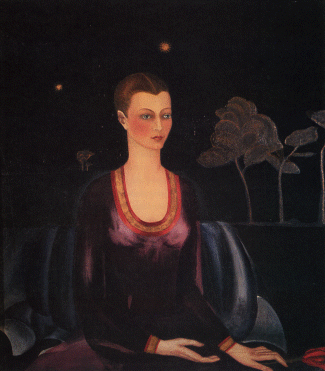 Portrait of Alicia Galant, 1927
Portrait of Alicia Galant, 1927
